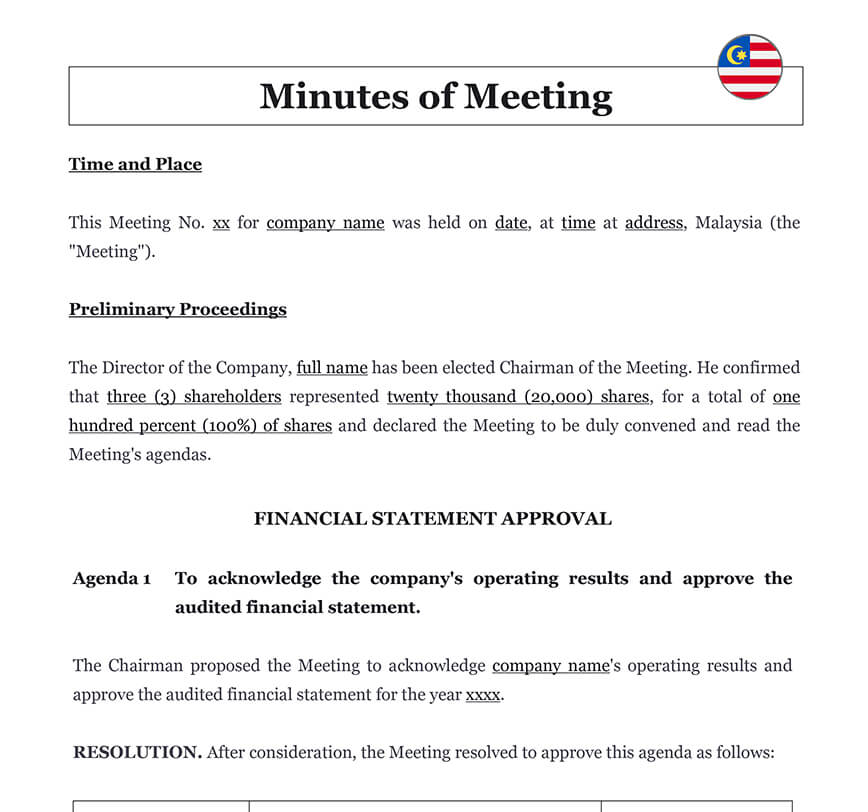Ready to use legal template
Drafted by experienced lawyers
Compliant with Malaysian law
Ready to use legal template
Drafted by lawyers
Compliant with Malaysian law
Home › Business contracts › Minutes of Meeting
Learn more about Minutes of Meeting in Malaysia
Minutes of Meeting are formal written records that summarize the discussions, decisions, and action items from a meeting. They serve as an official document that provides clarity on what was discussed, who participated, and what steps are to be taken next. In Malaysia, accurate meeting minutes are essential for both corporate governance and compliance with statutory requirements, particularly for board meetings, shareholders’ meetings, and internal company discussions. Minutes help ensure transparency, accountability, and a clear historical record of organizational activities. Whether for a company, association, or committee, maintaining proper minutes is a best practice that supports legal and administrative processes. Download our Minutes of Meeting template available in an easy to edit Word format and drafted by expert to be used in the Malaysia.
Table of contents
What are Minutes of Meeting?
Meeting minutes are notes taken during an annual general meeting or extraordinary. They outline the important subjects that will be discussed, motions that will be submitted or voted on, and activities that will be carried out. Meeting minutes are often taken by a designated member of the organization. Their job is to keep an accurate record of what happened during the meeting.
What is a General Meeting?
An Annual General Meeting (AGM) is a yearly gathering of interested shareholders of a firm. At an AGM, the company’s directors deliver an annual report to shareholders that includes information on the company’s performance and strategy. The annual general meeting (AGM) is held for shareholders to debate any issues concerning the company’s affairs and operations, as well as to engage with the company’s directors. The annual shareholders meeting is another name for the AGM. Shareholders having voting rights vote on current topics such as board of director nominations, executive remuneration, dividend distributions, and auditor selection.
What is included in the Meeting Minutes?
Meeting minutes generally include the following information:
| ➤ The date, place and hour of the meeting |
| ➤ Attendees' names, as well as those who were unable to attend |
| ➤ Acceptance of, or changes to, the minutes of the previous meeting |
| ➤ Activities carried out or agreed upon |
| ➤ Following steps |
| ➤ Election outcomes |
| ➤ Accepted or rejected motions |
| ➤ New venture |
| ➤ The next meeting date and time |
How to draft Minutes of Meeting?
There are five major processes involved in keeping meeting minutes. They are as follows:
| ➤ Pre-planning |
| ➤ Record-taking |
| ➤ Minutes writing or transcription |
| ➤ Distributing meeting minutes |
| ➤ Minutes are filed or saved for future reference |
When the meeting concludes, the person entrusted with writing minutes should be given all of the resources he or she requires to write up the minutes in a clear, presentable manner.
After the meeting, don’t take too long to jot down the minutes. This way, everything from the meeting is still fresh in your mind. Examine the outline you made previously and make any required changes. This may entail providing additional information or addressing some of the problems addressed. Also, ensure that all verdicts, activities, and motions are fully documented. Review the minutes to ensure they are concise yet understandable.
How to organize a General Meeting?
Taking minutes will be much easier if a meeting is well-planned in advance. However, the chairman and secretary or minutes-keeper should collaborate in advance to define the meeting’s agenda. For example, the person taking minutes might collaborate with the chair to create a paper that would act as an agenda and establish the meeting format.
Agenda for the Meeting
If the chair and secretary are unable to meet to prepare an agenda, it is the secretary’s responsibility to obtain a copy of the agenda before the meeting begins. The agenda will serve as a guide for taking notes and preparing the minutes. In addition, the agenda provides other elements that must be included in the minutes.
- Remarks:
When someone is appointed to keep the minutes, it is critical that they understand what is expected of them. As a result, the individual should approach the committee’s chair and inquire about their involvement in the meeting.
Who writes Minutes of Meeting?
The Board Secretary is usually the person in charge of taking meeting minutes on most boards. The minutes taker in an organizational meeting might be a project coordinator or an assistant to a management or CEO. She or he should come a few minutes early and provide an attendance sheet with all members’ names and contact information.
What are the different types of meetings in Malaysia?
1. Annual General Meeting
All new Malaysian firms must conduct their first AGM within 18 months of their establishment date. Following the first AGM, the meeting must be conducted each calendar year and no later than 15 months after the previous AGM. Two or more members who control at least 10% of the company’s share capital can convene an AGM.
2. Extraordinary General Meeting
An extraordinary general meeting (EGM) is a general meeting that is not the annual general meeting (AGM) and is also known as a special general meeting or an emergency general meeting. The EGM is used to debate pressing issues such as critical legal issues and the dismissal of key corporate members. Ordinary business topics and special business concerns are considered at the EGM in the same way as they are at AGMs. There are no criteria in Malaysia about when the EGM must be convened, and there is no penalty for failing to hold an EGM. The EGM can be held on any day within the company’s regular business hours. Two or more members who control at least 10% of the company’s share capital can convene an EGM.
3. Class Meeting
A class meeting is a shareholder meeting for corporations that issue several classes of shares, and only holders of a particular class of shares are permitted to attend and vote. In Malaysia, share classes are divided into two types: ordinary shares and preference shares. When the rights of the holders of a class of shares are to be amended, modified, or impacted, companies arrange class meetings. Only issues pertaining to a certain class of shares may be discussed.
4. Directors Meeting
This type of meeting is only for the company’s directors. They will run and operate the company’s day-to-day operations, while the directors will make all decisions. They will, however, not make decisions that are meant to be made by the shareholders.
SPECIAL OFFER
Startup
15 Document Package
Essential documents for running your business in Malaysia
Minutes of MeetingTemplate (.docx)
Save on attorney fees
310 client reviews (4.8/5) ⭐⭐⭐⭐⭐
Share information
Why Themis Partner ?
Make documents forhundreds of purposes
Hundreds of documents
Instant access to our entire library of documents for Malaysia.
24/7 legal support
Free legal advice from our network of qualified lawyers.
Easily customized
Editable Word documents, unlimited revisions and copies.
Legal and Reliable
Documents written by lawyers that you can use with confidence.




